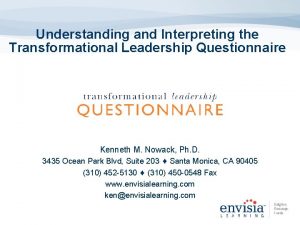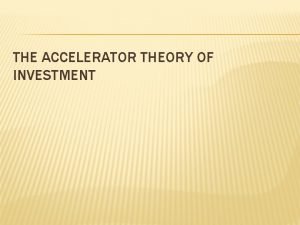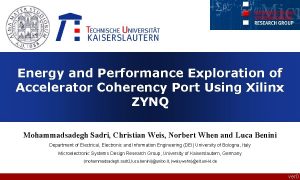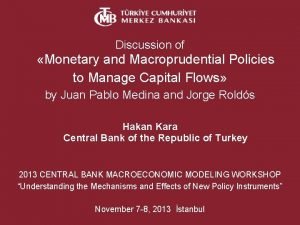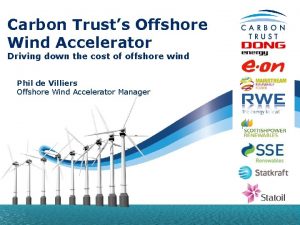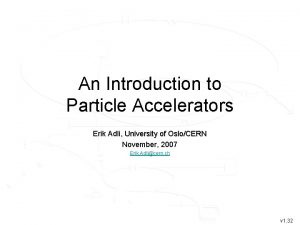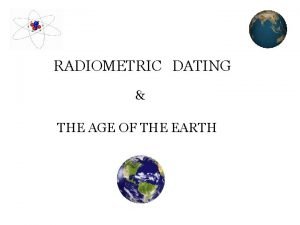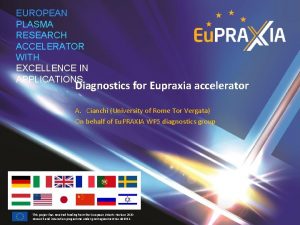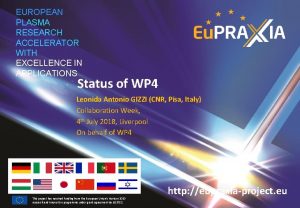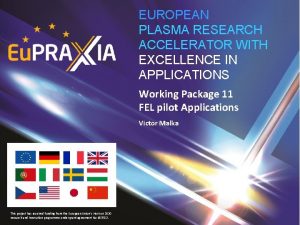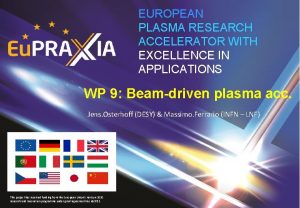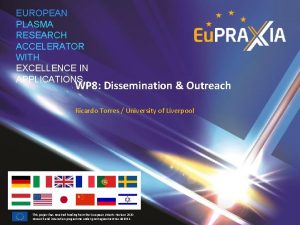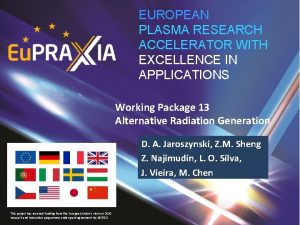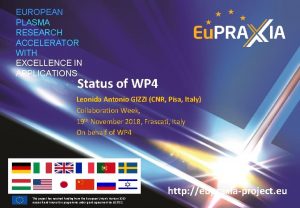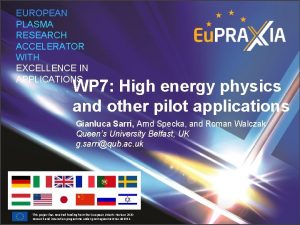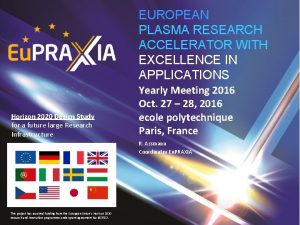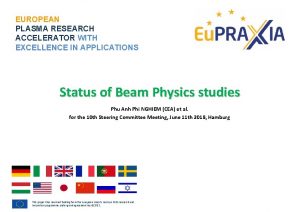EUROPEAN PLASMA RESEARCH ACCELERATOR WITH EXCELLENCE IN APPLICATIONS














- Slides: 14

EUROPEAN PLASMA RESEARCH ACCELERATOR WITH EXCELLENCE IN APPLICATIONS Laser R&D required François MATHIEU (CNRS, LULI, France) Co-Coordinator Eu. PRAXIA WP 4 – Laser design and optimization Yearly Meeting November 22 nd, 2017, Lisbon This project has received funding from the European Union’s Horizon 2020 research and innovation programme under grant agreement No 653782. http: //eupraxia-project. eu

CONTRIBUTORS • • • Horizon 2020 Istituto Nazionale di Ottica-CNR, Pisa Istituto Nazionale di Ottica-CNR, Firenze LULI – CNRS, Palaiseau STFC Rutherford Appleton Laboratory INFN – LNF, Frascati Hamburg University Lawrence Livermore National Laboratory THALES LASER AMPLITUDE TECHNOLOGIES … 2

CONTENT 1. 2. 3. 4. 5. Horizon 2020 Ti-Sa amplifiers 100 Hz pump laser Thermal management of gratings Stability control Pulse temporal shaping and synchronization We are focusing on P 1 requirements for Laser 3 : 5 Ge. V accelerator 3

Ti-Sa amplifiers Horizon 2020 • Ti-Sa is currently the gain medium in Eupraxia laser baseline design • Based on existing models about thermal load in Ti-Sa and cooling system Þ We have to design an amplifier producing 160 J, 100 HZ, with a spectrum aiming to a FT of 60 fs, and pumped by 240 J. F 50 J, 10 HZ pumped by 100 J, with a spectrum aiming to a FT of 30 fs. 4

Ti-Sa amplifiers Horizon 2020 • We need to test different configurations of Ti-Sa : crystal vs slabs (1) • With different types of coolant : water, He, … • Keeping in mind TASE! (1) : R. S. NAGYMIHALY, 1, H. CAO, 1 D. PAPP, 1 G. HAJAS, 1 M. KALASHNIKOV, 1, 2 K. OSVAY, 1 AND V. CHVYKOV 1 “Liquid-cooled Ti: Sapphire thin disk amplifiers for high average power 100 -TW systems”, OPTICS EXPRESS, VOL. 25, NO. 6, MARCH 2017, 1 ELI-HU, 2 Max Born Institute 5

100 Hz pump laser Horizon 2020 • As we are over 10 Hz, we are on Diode pump system • Starting from current design at 10 Hz and more than 60 J @ 532 nm Þ We need to design a pump system delivering at least 50 J, 100 Hz and ideally 60 J, 100 Hz, @ 532 nm. 6

100 Hz pump laser Horizon 2020 • Field of studies are : • New diodes and/or way to stack them • New gain materials • New scheme of cooling system 7

Thermal management of gratings Horizon 2020 • Based on existing studies on gratings front surface deformation under thermal load with or without cooling system • Based on existing studies about influence of gratings front surface on pulse compression • Based on existing materials (coating and substrate) Þ We need to design a compressor able to handle 10 W/cm² and a total power of 15 k. W without damaging after few days, compatible with the wavelength and the pulse duration. 8

Thermal management of gratings Horizon 2020 • Continue to develop thermal modeling • Validate the models with simple and not expensive tests • Test different types of technologies and substrate ‼ Take advantage of these tests to understand the actual limitation of the compressors due to gratings degradations ‼ Make a parallel approach for mirrors of the beam transport 9

Focus spot stability on target Horizon 2020 • Required Beam Pointing stability is almost one decade over (1) the existing performances ≈ 0, 2 µrad! • Required Intensity stability is around 5% Þ We need to invent a new way to “command” focal spot on target (1) : Kei Nakamura, Hann-Shin Mao, Anthony J. Gonsalves, Henri Vincenti, Daniel E. Mittelberger, Joost Daniels, Arturo Magana, Csaba Toth, and Wim P. Leemans “Diagnostics, Control and Performance Parameters for the BELLA High Repetition Rate Petawatt Class Laser”, IEEE JOURNAL OF QUANTUM ELECTRONICS, VOL. 53, NO. 4, AUGUST 2017, BELLA 10

Focus spot stability on target Horizon 2020 • Benchmark of existing facilities on intensity stability • Try on existing facilities active system with loops • Try on existing facilities passive system 11

Pulse temporal shaping Horizon 2020 • To be able to enhance energy transfer from laser to electrons • To be compatible with a train of moderate intensity ultrashort pulses • We need to develop new time manipulation techniques to : • Generate a train of ultrashort pulses, with 100 fs delays to each other • Control Temporal contrast 12

CONCLUSION Horizon 2020 • Eu. PRAXIA aiming at industrial-strength PW-k. W laser system, well beyond current state-of-the-art • Time to deliver this laser is not so far that we can launch fundamental research and only applied research • For these developments, budget is needed 13

Consortium Horizon 2020 16 Participants 22 Associated Partners (as of October 2016) 14
 Eden european destinations of excellence
Eden european destinations of excellence Abu dhabi award for research excellence (aare)
Abu dhabi award for research excellence (aare) European strategy forum on research infrastructures
European strategy forum on research infrastructures European commission community research
European commission community research Leadership accelerator questionnaire
Leadership accelerator questionnaire Limitations of accelerator theory of investment
Limitations of accelerator theory of investment Biztalk accelerator for swift
Biztalk accelerator for swift Netbackup accelerator
Netbackup accelerator Ib economics fiscal policy
Ib economics fiscal policy Accelerator coherency port
Accelerator coherency port Financial accelerator
Financial accelerator Offshore wind accelerator
Offshore wind accelerator Proton
Proton Netbackup accelerator best practices
Netbackup accelerator best practices Accelerator mass spectrometry
Accelerator mass spectrometry




